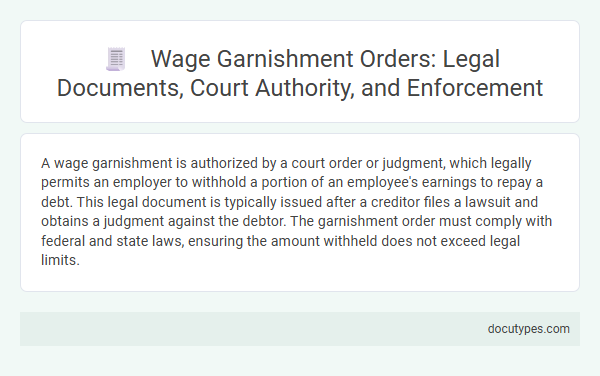A wage garnishment is authorized by a court order or judgment, which legally permits an employer to withhold a portion of an employee's earnings to repay a debt. This legal document is typically issued after a creditor files a lawsuit and obtains a judgment against the debtor. The garnishment order must comply with federal and state laws, ensuring the amount withheld does not exceed legal limits.
Introduction to Wage Garnishment Orders
A wage garnishment order is a legal document that permits an employer to withhold a portion of an employee's earnings for debt repayment. This order is issued by a court or authorized government agency to enforce a debt collection process.
- Wage Garnishment Order - This official court order directs your employer to deduct specified amounts from your wages to repay a creditor.
- Court Judgment - A final judgment from a court determining the amount owed often serves as the basis for a garnishment order.
- Government Agency Authorization - Certain agencies, such as the IRS or child support enforcement offices, can issue garnishment orders without a traditional court judgment.
Legal Foundations of Wage Garnishment
Which legal document authorizes wage garnishment? Wage garnishment is typically authorized by a court order or a governmental agency directive. This legal foundation ensures that employers deduct a portion of an employee's earnings to satisfy outstanding debts or obligations as mandated by law.
Court Authority in Wage Garnishment Cases
The legal document that authorizes wage garnishment is typically a court order issued after a creditor successfully files a lawsuit and obtains a judgment. The court authority ensures that garnishment is enforced within the legal limits set by state and federal law.
- Garnishment Order - A court issues this document to require an employer to withhold a portion of Your wages to satisfy a debt.
- Judgment Lien - This legal claim recorded by the court against Your property can lead to wage garnishment as part of debt recovery.
- Writ of Garnishment - The court issues this writ as a directive to a third party, like an employer, to deliver Your owed wages directly to the creditor.
Process for Issuing Wage Garnishment Orders
The legal document that authorizes wage garnishment is typically a court order or judgment. This order instructs your employer to withhold a portion of your wages to repay a debt.
The process for issuing wage garnishment orders begins with a creditor filing a lawsuit and obtaining a judgment. Once the court grants the judgment, it issues the wage garnishment order to the employer, who must comply by deducting the specified amount from your paycheck.
Required Legal Documents for Wage Garnishment
| Legal Document | Description |
|---|---|
| Wage Garnishment Order | A court-issued document authorizing an employer to withhold a portion of an employee's wages to satisfy a debt. This document is essential and legally mandates the garnishment process. |
| Judgment Lien | A legal claim granted by a court against a debtor's property following a monetary judgment. While not directly authorizing wage garnishment, it supports enforcement actions, including garnishment. |
| Notice of Garnishment | A formal notification sent to both the employer and the employee indicating that wage garnishment has been authorized. This document ensures all parties are informed of the deduction. |
| Administrative Wage Garnishment Order | Issued by a government agency without court approval in cases like federal student loans or taxes. It authorizes the collection of debts directly from wages under specific statutes. |
| Debt Collection Lawsuit Judgment | The final court decision establishing the debtor's obligation to pay. This judgment serves as the basis for obtaining a wage garnishment order. |
Your employer cannot legally withhold wages without one of these official legal documents authorizing the garnishment.
Employer Responsibilities in Wage Garnishment
The legal document that authorizes wage garnishment is typically a court order or a government agency directive. Employers must comply with this document to legally withhold a portion of an employee's wages.
- Court Order - This document mandates the employer to deduct a specified amount from the employee's wages to satisfy a debt.
- Employer Notification - Employers receive official notification outlining the wage garnishment details and required deductions.
- Compliance Requirement - Employers are responsible for withholding and remitting the garnished wages according to legal limits and timelines.
Your employer is legally obligated to follow the wage garnishment order to avoid penalties and ensure correct processing.
Rights and Protections for Debtors
The legal document that authorizes wage garnishment is typically a court order or judgment. This document directs an employer to withhold a portion of wages to pay outstanding debts.
Your rights and protections as a debtor include limits on the amount that can be garnished from your wages. Federal and state laws often protect a portion of your income to ensure you can cover basic living expenses. It is important to review the specific garnishment limits and exemptions that apply in your jurisdiction.
Enforcement Mechanisms for Wage Garnishment Orders
The legal document that authorizes wage garnishment is typically a court order or judgment issued against a debtor. This order directs the employer to withhold a portion of the employee's wages to satisfy outstanding debts such as child support, taxes, or creditor claims. Enforcement mechanisms include regular wage withholding, employer compliance monitoring, and penalties for noncompliance to ensure repayment of the indebted amount.
Challenging and Modifying Wage Garnishment Orders
The legal document that authorizes wage garnishment is typically a court order or judgment issued by a judge. Challenging a wage garnishment order requires filing a motion with the court to dispute the validity or amount of the garnishment. Modifying a wage garnishment order can occur if the debtor's financial situation changes, and the court may adjust the garnishment amount accordingly upon request.
Which Legal Document Authorizes Wage Garnishment? Infographic

